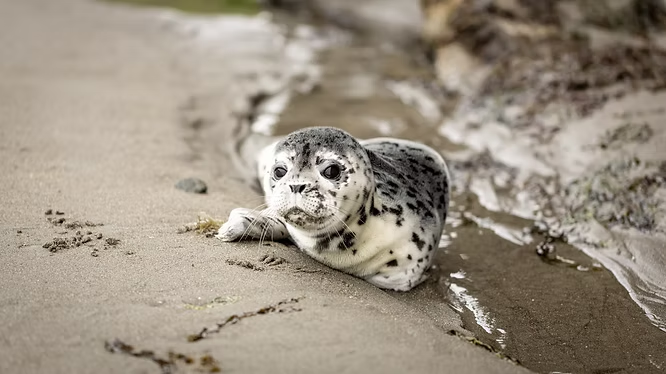Hooded Seals: Description and Behavior
Hooded seals (Cystophora cristata) are named for the inflatable hood that extends from their nose to forehead, forming a balloon-like display in adult males. These seals have a black face with a blue-gray coat patterned with dark patches. Males reach 2.5–3 meters in length and weigh 300–400 kg, while females are smaller at 2–2.4 meters and 160–230 kg. Known for their stamina, they dive over 1,000 meters for more than 50 minutes and can live 30–35 years.
More aggressive than other seal species, males use their inflatable hoods and a red nasal membrane for dominance displays, especially during breeding. These features serve as warnings and play a role in competition for territory and mates.
World Range and Habitat
Hooded seals inhabit deep waters across the far North Atlantic, from Svalbard to the Gulf of St. Lawrence. Four main populations breed on pack ice:
- Near Jan Mayen Island
- Off Labrador and northeastern Newfoundland
- In the Gulf of St. Lawrence
- In the Davis Strait
With an estimated global population of 650,000, they are highly migratory, ranging as far west as Alaska and south to the Canary Islands. Seasonal migrations include long-distance feeding journeys, molting on the ice in summer, and dispersing again until breeding season resumes in late winter.
Feeding Behavior
These deep-diving predators feed at 100–600 meters. Their diet includes Greenland halibut, redfish, cod, wolffish, capelin, herring, as well as squid, octopus, shrimp, and mussels. Predators include polar bears, Greenland sharks, and orcas.
Life History
Females mature at 3–6 years, males at 5–7 years. Pups are born between March and April with a blue-gray coat, earning them the nickname “bluebacks.” Nursing lasts only 3.8 days, the shortest of any mammal, yet pups double in weight thanks to milk rich in 60–70% fat. After weaning, females mate in the water while males compete aggressively for territory and additional partners.
Conservation Status
Historically hunted for their pelts, especially bluebacks, hooded seals suffered significant losses until trade bans in the 1980s reduced commercial pressure. However, illegal hunting persisted, and unreported kills remain a concern. Today, commercial hunts continue in parts of Norway, Russia, and Greenland, though declining markets and government subsidies shape the industry.
Additional threats include gillnet entanglement, reduced prey from overfishing, and calls for culls due to perceived competition with fisheries. In North America, growing numbers of hooded seals are observed further south, some requiring rescue and rehabilitation, likely linked to changing food availability.

